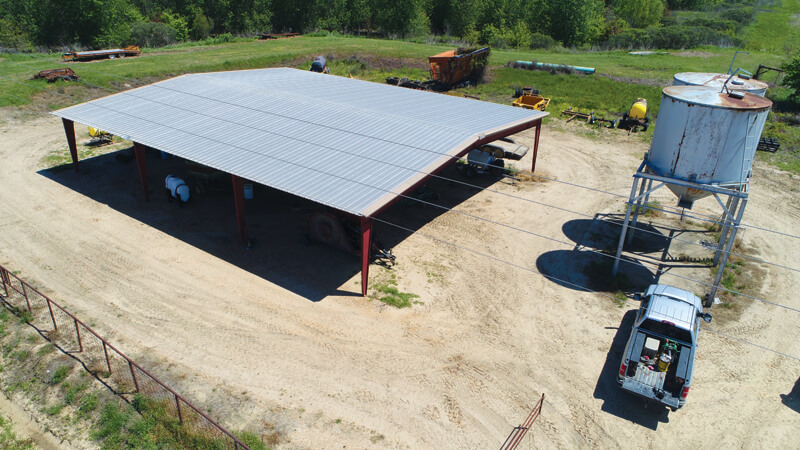By Mark H. Stowers • Photography by Johnny Jennings
Jacob Sartain didn’t grow up on a family farm with a unique farm headquarters and shop. He didn’t plant a field until his late 20s. But the family business did have him walking turnrows as Sartain is the third-generation owner of the family real estate business dating back nearly seven decades. The business has also done land development and management for the past two decades.
Sartain entered the farming business when he bought some land in Humphreys County and uses it as his headquarters.
“My shop is basically a forty-foot by eighty-foot building that I bought on an old catfish farm and we’ve been hanging out under the roof ever since,” says Sartain. “It doesn’t have a grand history behind it.”
The open-air structure is a tractor shed style building.
“I’ve got a big shipping container on one end that we put all of our lock up tools in. The ones that are too small or too valuable to leave out,” he says. “In the winter we put our planters and spray booms and water trailers under there. Anything that has a motor or weather sensitive equipment goes under the structure for protection.”
With his land spread out around the Delta, Sartain uses the shop as a base camp for his mobile farming operation.
“I’ve got a welding trailer that we pull up beside whatever we need to work on right there,” he says. “Because of the nature of our business, we have to be more mobile as compared to the guy who does traditional agriculture. Most farmers work within a closer radius of their shop. For us, we do pipe fabrication and installation work on some of these managed properties so we need to be able to move our equipment with us. We can go onsite and build and install the fabricated product whether it be a pipe or a bridge or a duck blind.”
His base of operation is in Humphreys County, but Sartain lives in Madison where the business office is located.
“We’ve always operated between Belzoni and Yazoo City, but in 1980 my father moved to Madison County,” he says. “Beyond the farming, we’ve been in the real estate business for sixty-six years. An enormous amount of our business has gone on in this area.”
Sartain does have a helping hand or two with the farming side.
“It’s been a steep learning curve, but luckily I have alot of good friends who are production farmers,” he says. “I have valuable resources between them and my input suppliers. I didn’t grow up doing this, but I did grow up on the land side of things. It’s been tough but I like that type of ‘on the go job experience.’ I have a gentleman who works with me that is a thirty-three-year farmer that I hired two years ago. We sent him to school to be an accredited farm manager and he is one of only two American Society of Farm Managers living in the state of Mississippi.” His role is invaluable as he oversees our firm’s agriculture management division.
Sartain’s unique farming story began at the age of twenty-nine with the purchase of the Humphreys County land.
“I got into farming because I was starting to acquire real estate and it was a tool to help cash flow the investment business of real estate,” says Sartain. “Good move, bad move – who knows? The way I built my business was a mix of production farms and wildlife farms. We do that at a pretty large scale on the wildlife side. If you take out the two flood years, prior to the 2019 crop year, we were farming 1,000 acres of unharvested row crops just for wildlife in a quad county area – Humphreys, Yazoo, Leflore and Sunflower.”
With his 750 acres under commercial production, Sartain has to use different planting methods for the different acreage.
“We grow corn, milo, and soybeans, but we don’t harvest it. The main crop for wildlife is corn but we take a slightly different approach with field conditions,” he says. “In wildlife you often don’t have the chance to row it up due to later planting dates and the need to conserve available ground moisture. In the fall when you have hunters out there, the flat fields also help them from stumbling and tripping over rows. So, we plant everything flat.”
His wildlife acreage is used mainly for duck hunting with quite a bit of deer hunting as well.
“I’ve been acquiring farms since my mid-20s,” he says. “In the past decade I’ve gotten up to about 2,200 acres of mix use land.”
The agricultural and recreational land broker/developer has separate business entities that all work together. Sartain Heritage Properties is the brokerage division, while J. Sartain Construction and Development – handles the land developments and farming operations.
“Whether its growing custom crops or land development and management, our staff is prepared to handle all aspects of agricultural and recreational lands for our investment clients.” he says. “They take care of day to day matters and legal matters – executing contracts for leases, paying taxes, looking for subsidy programs beneficial to the farm or make recommendations to further improve the farm for its highest and best use. Our goal as a company is to be able to take a landowner from start to finish.”
Sartain’s firm manages more than 15,000 acres of land for wildlife and row crops that stretches across the Delta. In addition to its brokerage division which handles thousands of acres of acquisitions and dispositions annually.
“We implement programs for private landowners, designing and implementing both agriculture and conservation restoration projects,” he says. “We own our own equipment to do the work but sometimes we contract things just so we can get it done faster.”


